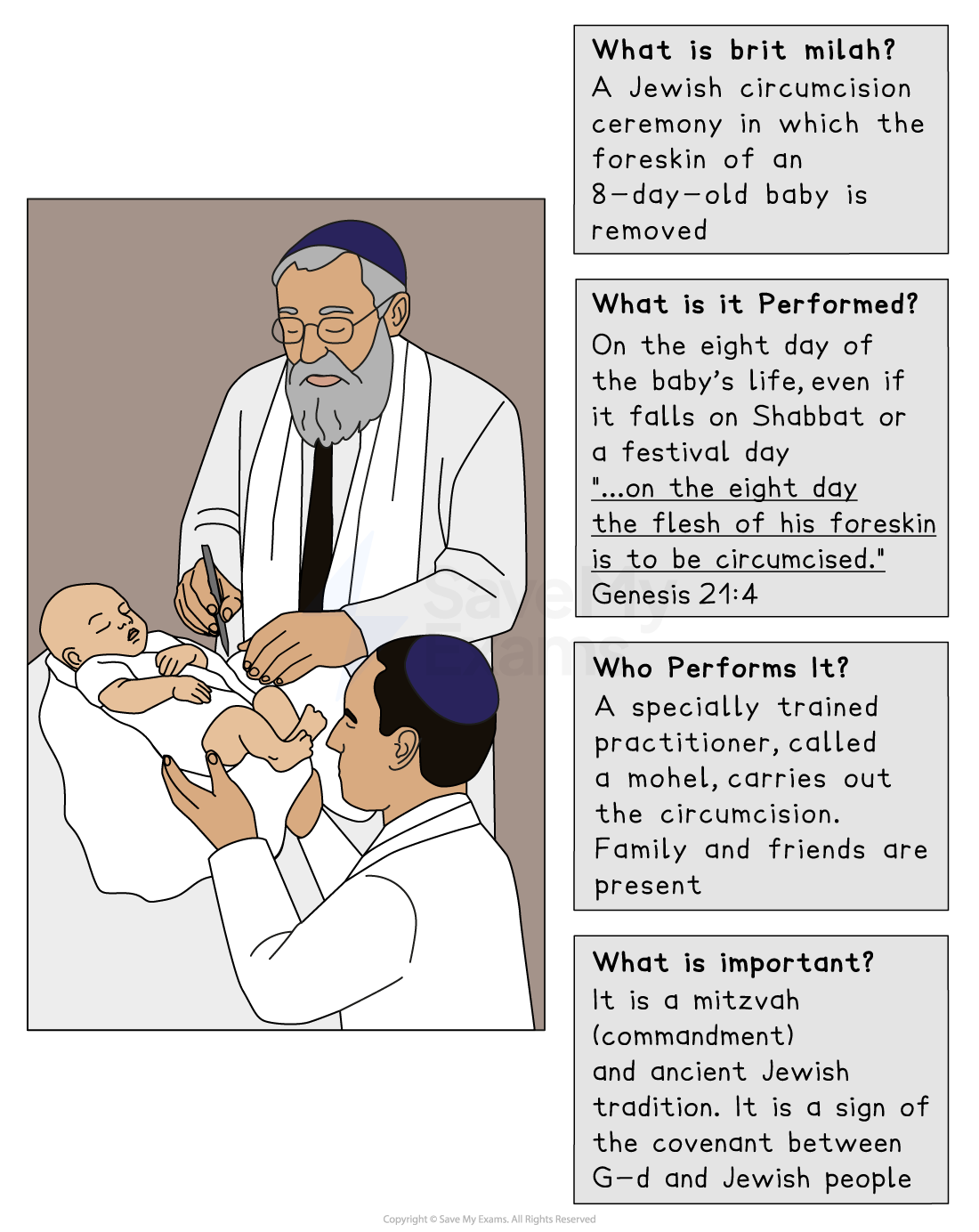Jewish Birth Rites (Cambridge (CIE) IGCSE Religious Studies): Revision Note
Exam code: 0490
What is brit milah?
Jews observe many rituals throughout their lives, marking key events, including:
Brit milah
Bar Mitzvah
Bat Mitzvah
Marriage
Mourning rituals
Brit milah is the Hebrew term used to describe the religious circumcision of boys when they are eight days old or of older males converting to Judaism:
It is carried out by a mohel (male) or, in some Reform communities, a mohelet (female)
Circumcision involves the removal of the foreskin and is a traditional Jewish practice
Circumcision dates back to the book of Genesis, when G-d commands Abraham to circumcise himself and his offspring as a sign of the covenant between Jews and G-d
What are the rituals of brit milah?
There are certain practices that are common during the Brit Milah ceremony
During the ceremony, a male or female friend or relative will act as a messenger, or a kvatter
The female kvatter will hand the baby to the male kvatter, who will be wearing a tallit
He will carry the boy into a room where the males of the family are gathered
The child is placed on the lap of the sandek:
A sandek is someone chosen by the parents as a great honour and is often the grandfather
The mohel recites a blessing before the baby is circumcised:
“Blessed art Thou, O Lord our G-d, King of the universe, who hast sanctified us with Thy commandments, and hast given us the command concerning circumcision”
As soon as the mohel begins the circumcision, the father (or, in some cases, both parents) recites:
“Blessed art Thou, O Lord our G-d, King of the universe, who hast sanctified us with Thy commandments, and hast commanded us to make our sons enter the covenant of Abraham our father”
All people present then respond:
“Even as this child has entered into the covenant, so may he enter into the Torah, the nuptial canopy, and into good deeds”
The mohel then blesses a cup of wine and announces the baby’s name in Hebrew and English
A drop of wine is placed on the baby’s tongue
The circumcision is performed in front of a minyan
The baby is placed on a cushion on an empty chair that is known as Elijah’s chair:
This represents an ancient belief that the spirit of Elijah visits every circumcision
After the circumcision, the father receives a blessing
During the Brit Milah, a prayer is said that shows the importance of the ceremony for a child’s relationship with G-d:
“That as this child has entered into the covenant, so may he enter into the Torah, the marriage canopy and into good deeds”

What are Jewish naming ceremonies, and why are they important?
Jewish naming ceremonies are important rites of passage that welcome a new baby into the Jewish community and give them their Hebrew name
A child’s Hebrew name is formally announced and given (according to traditional custom, for the first time) during the brit milah or brit bat ceremony
There are different ceremonies for baby boys and baby girls
Baby boys have a brit milah (Covenant of Circumcision)
This takes place on the eighth day after birth, even if it falls on Shabbat or a festival day
The circumcision is performed by a mohel (a trained Jewish practitioner)
The baby is given their Hebrew name during the ceremony
The ceremony marks the sign of the covenant (brit) between G-d and the Jewish people
Naming marks the child’s entrance into the covenant
The family and friends gather for the celebration
For baby girls, the ceremony is called simchat bat (joy of a daughter) in most Orthodox traditions
Usually, this takes place within the first month after birth, but there is no fixed date, and the timing can vary depending on family or synagogue custom
The ceremony may take place at home or in a synagogue
A baby girl is given her Hebrew name
Prayers, blessings and sometimes readings or songs are included
In some communities, the naming happens during a Torah reading in a synagogue
The ceremony welcomes the girl into the Jewish community
It celebrates the gift of life and G-d’s blessings
The ceremony for baby girls in Reform or Liberal Judaism is known as Brit Bat (Covenant of a Daughter)
The difference between brit bat and simchat bat is that brit bat places more emphasis on the baby girl’s entrance into the covenant with G-d
Brit bat is likely to be more ritualised than simchat bat
It is designed to parallel Brit Milah for boys, highlighting gender equality and inclusion in the covenant
It may also include symbolic rituals, such as wrapping the baby girl in a tallit
Worked Example
Give two reasons why the ceremony of Brit Milah takes place
[2 marks]
Answer:
So that the baby can be given his Hebrew name [1 mark]
The ceremony represents the covenant (brit) between G-d and the Jewish people
and marks the child’s entrance into the covenant [1 mark]
Examiner Tips and Tricks
For this section, there are certain things to be aware of that will help to support the preparation for this topic:
Tip | Why it helps |
|---|---|
Use key terms | Shows strong subject knowledge |
Explain the significance | Not just what happens but why it matters |
Compare ceremonies | Shows depth of understanding |
Refer to beliefs/Scripture | Supports evaluation and higher-level analysis |
Practise exam formats | Builds confidence and accuracy |

Unlock more, it's free!
Did this page help you?